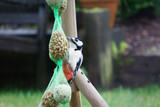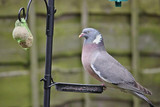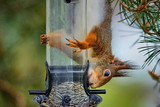Spring bird watching - What can you do to prepare?
Spring bird watching
Spring bird watching. When March rolls around, it’s safe to say that Spring is on its way, what with the air getting warmer and the evenings getting lighter. You will also know that as a birdwatcher, your wild garden birds will have been preparing for some time now, chirping in the trees and preparing their nests. But just because winter is coming to a close and the worst of the weather is behind us, it doesn’t mean you should stop giving them a helping hand. Research has actually shown many birds are declining in numbers, which is probably due to human activity, like the removal of hedgerows and the building on natural lands. That is why we should attempt to compensate for the loss of our wild birds losing their food source. It has been proven that feeding birds with quality, natural food in the spring and summer months can make all the difference. The more you do in these months the more likely it is they will flourish and continue to return all year round. You will also have peace of mind that you are continuing to do your bit to help the birds - so remember this rhyme - “Spring feeding will help breeding”Look out for birds building nests
Depending on the species of bird you have in your garden, you may find various nesting materials lying around. Tits will opt for the softest nesting materials available to them, like cat hair, dried grass and even cobwebs! Birds such a Pigeons will put a few twigs together to nest their young in. Whatever way your wild garden birds choose to build their nest, we always recommend giving them some additional support with our great collection of nest boxes. These will ensure they are breeding in the best possible environments.Keep an eye out for fledglings
In the next few weeks, you might be lucky enough to see a couple of fledglings. The lack of a harsh winter means some species, such as Blackbirds will nest earlier than they once used to. It would not be strange to see a young fluffy Thrush or Blackbird cautiously following its parent around your garden.How to help fledglings in spring time
To give them the best possible start, it’s imperative to provide high energy, good quality bird food that can be easily digested by small fledglings. Our split peanuts for birds and sunflower heart chips are of a particular benefit to fledgling birds. The peanuts are split, meaning fledglings avoid the possibility of choking. They are also rich in oils and protein, great for keeping beaks and feather is pristine condition. Live mini mealworms, in particular, are fantastic for fledglings as they are easier to consume than the regular live mealworms. They are both an excellent source of protein that will help the birds grow up fast and strong For the ultimate hit of energy, suet pellets are a great nutritious blend, utterly packed with energy. This kind of food will give an instant boost to hungry, growing fledglings. Many believe suet is just for winter, but the suet pellets, in particular, are great all year round. Finally, with the likelihood of a large number of birds in your garden searching for food for their young, you will need to keep your bird feeders and tables clean to avoid the risk of infection from parasites.Be aware of declining bird species
In our last article we talked about the sheer decline of House Sparrows over the years due to home and garden redevelopments. The House Sparrow is a famous example, but ornithologists have also noticed a steady decline in the amount of Willow Tits, Song Thrushes and Pied Wagtails. This is why it’s incredibly important to carry on feeding birds throughout the year, and Spring is no different. The best thing you can do is leave out a variety of different, high-quality foods, whilst being aware of those pesky Squirrels who like to help themselves to your bird seed.22nd Feb 2017
Explore Popular Articles
-
8 Easy Ways to Attract Woodpeckers to Your Garden
8th Apr 2024Woodpeckers are among the most interesting birds known for their drumming sound and bright colours.
-
How to Protect Your Bird Feeders from Pigeons ?
28th Mar 2024You must have noticed damaged feeding ports, hanging mechanisms, perches, lids and bottoms. Who coul
-
5 Foolproof Ways to Rat-Proof Your Bird Feeder
18th Mar 2024Building a bird-friendly environment is a delightful endeavour, but it involves the responsibility o




